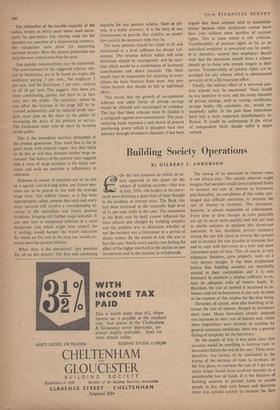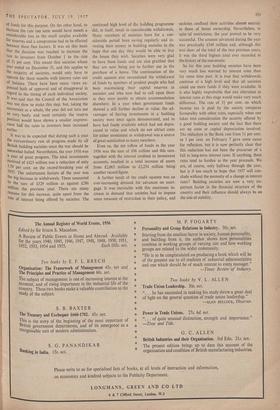Building Society Operations
By GILBERT J. ANDERSON ON the last occasion on which an ar- ticle appeared in this paper on the subject of building societies—that was in July, 1956—the leaders of the move- ment were directing a great deal of their thought to the problem of interest rates. The Bank rate had been increased to the unusually high level of 5+ per cent. early in the year. The movement in the Bank rate by itself cannot influence the rates offered and charged by building societies and the problem was to determine whether or not the increase was a forerunner to a period of dearer money. By the month of July this was in fact the case. Nearly every society was feeling the effect of the higher rate both in the decline in new investments and in the increase in withdrawals. The timing of an alteration in interest rates is not always easy. The outside observer might imagine that societies would always proceed firstly to increase the rate of interest to borrowers and thereafter, on completion of this rather pro- longed and difficult operation, to increase the rate of interest to investors. This procedure, however, is almost impossible of achievement. FrOm time to time changes in rates generally are apt to occur quite quickly and will not stop to enable societies to perform this drawn-out operation. It has, therefore, proved necessary during the last fe;,v years to reverse this process and to increase the rate payable to investors first and to cope with borrowers at a later and more convenient point of time. This, of course, is very expensive. Societies, quite properly, work on a very narrow margin. It has been emphasised before that building societies are essentially mutual in their composition and it is only necessary to maintain a surplus sufficient to en- sure an adequate ratio of reserve funds. If, therefore, the rate of interest is increased to in- vestors and not to borrowers, it can only be done at the expense of this surplus for the time being.
Directors, of course, were also unwilling to in- crease the rate of interest charged to borrowers once more. Many borrowers already endured two increases in their rate of interest and, whilst these impositions were dictated to societies by general monetary conditions, there was a general feeling of sympathy for the borrowers.
By the month of July it was quite clear that societies would be unwilling to increase rates to borrowers before the end of the year. There were, therefore, two factors to be considered in the timing of the increase of rates to investors. In the first place, to continue the rate of 3 per cent. much longer would have involved societies in a considerable loss of funds. It is the business of building societies to provide funds to enable people to buy their own homes and therefore there was natural anxiety to increase the flow of funds for this purpose. On the other hand, to increase the rate too soon would have meant a considerable loss in the small surplus available for reserves and a compromise had to be effected between these two factors. It was on this basis that the decision was reached to increase the rate to investors from October 1 to the rate of 31 per cent. This meant that societies whose year ended on December 31, and this applies to the majority of societies, would only have to operate for three months with interest rates out of balance. There have been many views ex- pressed both of approval and of disapproval in regard to the timing of each individual society. It was said that the Council of the Association was too slow to make this step, but, taking the movement as a whole, the year did not turn out so very badly and most certainly the reserve position would have shown a smaller improve- ment had the rates to investors been increased earlier.
It was to be expected that during such a year the extraordinary rate of progress made by all British building societies since the war should be somewhat halted. Nevertheless, the year 1956 was a Year of great progress. The total investments received of £425 million was a reduction of only 1.39 per cent, on the record-breaking year of 1955. The unfortunate feature of the year was the big increase in withdrawals. These amounted to the sum of £329 million as against £286 Million the previous year. There are many reasons for this increase, quite apart from the rate of interest being offered by societies. The continued high level of the building programme did, in itself, 'result in considerable withdrawals. Many members of societies have for a con- siderable period been saving regularly and in- vesting their money in building societies in the hope that one day they would be 'able to buy the house they wish. Societies were very glad to have these funds and are also gratified that they are now being put to further use in the purchase of a home. The continuation of the credit squeeze also necessitated the withdrawal of funds by numbers of prudent people who had been maintaining their capital reserves in societies and who now had to call upon them as they were unable to obtain accommodation elsewhere. In a year when government funds showed a still further decline in value, the ad- vantages of - having investments in a building society were once again demonstrated, and to have had funds available which had not depre- ciated in value and which do not attract costs for either investment or withdrawal was a source of great satisfaction to many members.
Even so, the net inflow of funds in the year 1956 was the sum of £96 million and this sum, together with the interest credited to investment accounts, resulted in a total increase of assets from £2,065 million to £2,234 million being another record figure.
A further result of the credit squeeze was an ever-increasing demand for advances on mort- gage. It was inevitable with this enormous in- crease in demand that societies had to impose some measure of restriction in their policy, and societies confined their activities almost entirely to those of home ownership. Nevertheless, in spite of restrictions, the year proved to be very successful. The amount advanced during the year was practically £340 million and, although this was shot.e of the total of the two previous years, it was the third highest total ever recorded in the history of the movement.
So far this year building societies have been very much less worried by interest rates than for some time past. It is true that withdrawals continue at a high level and that all societies could use more funds if they were available. It is also highly improbable that any alteration in interest rates at this stage would make very much difference. The rate of 3+ per cent. on which income tax is paid by the society compares favourably with other rates, especially when one takes into consideration the security offered by a good building society and the fact that there are no costs or capital depreciation involved. The reduction in the Bank rate from 51 per cent. to 5 per cent. on February 7 gave some cause for reflection, but it is now perfectly clear that this reduction has not been the precursor of a fall in long-term interest rates. If anything, these rates tend to harden as the year proceeds. We are, of course, only halfway through the year, but is it too much to hope that 1957 will con- clude without the necessity of a change in interest rates? Building societies are now a very im- portant factor in the financial structure of the country and their influence should always be on the side of stability.















































 Previous page
Previous page